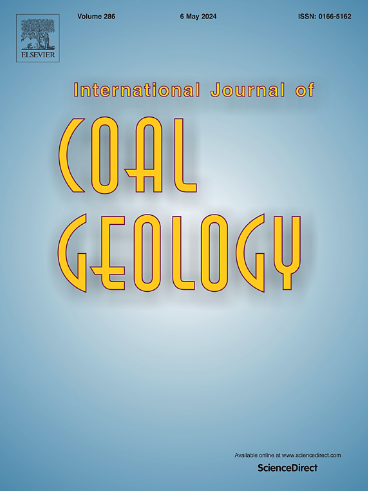对肯塔基粉煤灰中稀土元素酸提废灰的微束电子束研究
IF 5.7
2区 工程技术
Q2 ENERGY & FUELS
引用次数: 0
摘要
正如之前的研究所讨论的,从肯塔基州东部的高挥发性烟煤混合物中提取的粉煤灰经过选矿,得到了碳和尖晶石减少的- 75 μm产品。在中试装置中,将粉煤灰与强酸反应,提取稀土元素及其他主要和次要元素。在这项研究中,通过扫描电子显微镜(SEM)和能量色散光谱(EDS)检查了抛光,环氧结合颗粒的选矿和酸萃取灰烬。使用聚焦离子束(FIB)技术提取抛光切片,并通过透射电子显微镜(TEM)和能谱仪(EDS)进一步检测。原始进料灰分(未采用微束法研究)、选矿灰分和酸提灰分的总体化学性质表现出相似的上大陆地壳归一化稀土模式。体化学分析表明,除SiO2外,处理灰分中REE、V、Cr、Mn、Ni、As、Rb、Sr、Zr、Ba、Pb等主要氧化物的浓度均低于选灰。粉煤灰呈h型分布(LaN <;LuN)具有强m类型(介质类型:LaN/SmN <;1、GdN/LuN >;1)的贡献。在稀土元素和稀土元素中,SEM-EDS和TEM-EDS显示含Y的锆石(以及Ce、Nd和Gd,可能来自相邻的独居石);磷钇矿;一种富镝的xenotime-structure矿物;和轻REE (La, Ce, Pr, Nd, Sm), Gd, Dy, Er, Th的独居石。玻璃状的富al - si飞灰球显示Ce, Nd, Sm和Dy的存在,但在SEM视图尺度上没有可识别的矿物。某些球在纳米晶核周围呈现出2 ~ 4 μm的非晶边缘。随着散装粉煤灰中元素的消耗,非晶态边缘显示出Si的相对增加和其他元素的消耗或明显消除,包括REE。2 ~ 4 μm颗粒的明显缺失可能意味着这些颗粒完全或大部分被酸溶解,或者是多次洗涤-过滤循环从废灰中去除渗滤液的结果。处理比中试规模研究中处理的更细的颗粒和/或更多破碎颗粒的组合,可能通过预处理步骤,将允许酸更大程度地渗透到粉煤灰颗粒内部,从而导致更高的稀土回收率。本文章由计算机程序翻译,如有差异,请以英文原文为准。
Electron microbeam investigations of the spent ash from the pilot-scale acid extraction of rare earth elements from a beneficiated Kentucky fly ash
Fly ash derived from the combustion of an eastern Kentucky high volatile bituminous coal blend was, as discussed in previous studies, beneficiated to yield a − 75-μm product with a reduction in the carbon and spinels. The beneficiated fly ash was reacted with a strong acid in a pilot-scale unit to extract rare earth elements (REE) and other major and minor elements. In this study, polished, epoxy-bound pellets of the beneficiated and acid-extracted ashes were examined via scanning electron microscopy (SEM) and energy dispersive spectroscopy (EDS). Selected slices of the polished section were extracted using a focused ion beam (FIB) technology and further examined via transmission electron microscopy (TEM) and EDS. The bulk chemistry of the original feed ash (not studied by microbeam methods), the beneficiated ash, and the acid-extracted ash exhibit similar Upper Continental Crust-normalized REE patterns. The bulk chemistry indicates that the concentrations of the major oxides (aside from SiO2), REE, V, Cr, Mn, Ni, As, Rb, Sr, Zr, Ba, and Pb are less in the processed ash compared to the beneficiated ash. The fly ashes have H-type distributions (LaN < LuN) with a strong M-type (medium type: LaN/SmN < 1, GdN/LuN > 1) contribution. Among the REE and Y, SEM-EDS and TEM-EDS showed the presence of zircon with Y (and Ce, Nd, and Gd, perhaps from an adjacent monazite); xenotime; a Dy-rich xenotime-structure mineral: and monazite with light REE (La, Ce, Pr, Nd, and Sm), Gd, Dy, Er, and Th. Glassy Al-Si-rich fly ash spheres showed the presence of Ce, Nd, Sm, and Dy but no discernable minerals at the scale of the SEM view. Certain spheres showed 2- to 4-μm amorphous rims surrounding nano-crystalline cores. As with the depletion of elements in the bulk fly ash, the amorphous rims showed a relative increase in Si and a depletion or apparent elimination of other elements, including the REE. It is possible that the apparent absence of 2- to 4-μm particles may mean that these particles were totally or largely dissolved by the acid or as a consequence of multiple wash-filtration cycles to remove leachate from the spent ash. Processing of a combination of a finer size than processed in this pilot-scale investigation and/or more fractured particles, perhaps via a pre-processing step, would permit a greater penetration of the acid into the interior of the fly ash particles, leading to a greater recovery of REE.
求助全文
通过发布文献求助,成功后即可免费获取论文全文。
去求助
来源期刊

International Journal of Coal Geology
工程技术-地球科学综合
CiteScore
11.00
自引率
14.30%
发文量
145
审稿时长
38 days
期刊介绍:
The International Journal of Coal Geology deals with fundamental and applied aspects of the geology and petrology of coal, oil/gas source rocks and shale gas resources. The journal aims to advance the exploration, exploitation and utilization of these resources, and to stimulate environmental awareness as well as advancement of engineering for effective resource management.
 求助内容:
求助内容: 应助结果提醒方式:
应助结果提醒方式:


